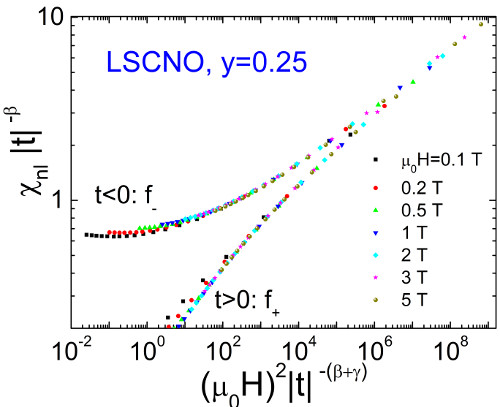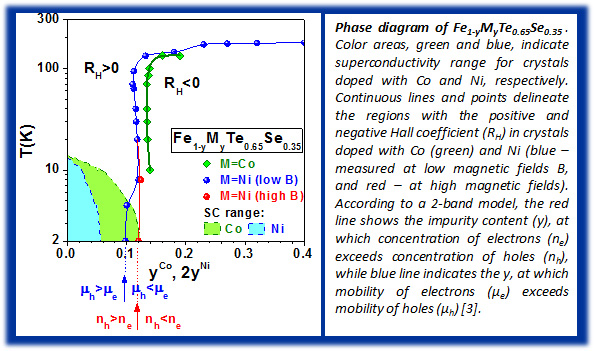Mechanisms of superconductivity studied by impurity doping
More than 50 years ago Abrikosov and Gor’kov derived the famous formula describing the influence of impurities on the superconducting
transition temperature, Tc. According to their theory the enhancement of the scattering rate by magnetic impurities suppresses the Tc in superconductor with isotropic superconducting gap (s-wave gap, as in conventional superconductors), while nonmagnetic impurities have no effect on superconductivity. On the other hand, in case of strongly anisotropic gap the Tc should be reduced not only by magnetic but also by nonmagnetic impurities. Indeed, the suppression of superconductivity by doping with Zn (nominally nonmagnetic impurity) has been shown to occur in cuprates with d-wave order parameter [1].
The interpretation of the doping experiments is not always straightforward, because impurities may affects not only scattering rates, but also other properties of the system, such as the shape of
the Fermi surface, or the magnetic properties away from impurities. Therefore, it is necessary to study not only superconducting properties, but also normal state, before reaching any conclusion on
the influence of impurities on superconductivity. Our most recent studies focus on two types of unconventional superconductors, cuprate La2-xSrxCuO4 (LSCO), and iron-based chalkogenide FeSeTe.
Although LSCO may be seen as the simplest archetypal compound among high-Tc cuprates, its reach phase diagram can serve as a natural playground to test various theories of unconventional superconductivity. Ni is a unique dopant in cuprates because of its ability to build NiO6 octahedron, being an analog of CuO6 octahedron an essential block of LSCO structure.
Increasing the substitution of Ni ions into the Cu sites in LSCO leads eventually to isostructural and non-superconducting nickelate La2-xSrxNiO4 (LSNO).
Recently, Ni was claimed to serve only as a charge dopant in LSCO, without playing any magnetic role, when its concentration y is smaller than the hole concentration p in the system. The measurements of the local distortions around the Ni ions replacing Cu ions in La2-xSrxCu1-yNiyO4 (LSCNO) suggest that for y<p (where p is equal to Sr content,
x), Ni acts only as a hole absorber without disturbing the antiferromagnetic (AF) spin-1/2 network in the Cu-O planes of LSCO. Based on this, a magnetic-impurity picture for Ni dopant in cuprates
was completely disqualified (H. Hiraka at al., PRL 2009).
Our recent study [2] has been shown that this is an incorrect conclusion, i.e. the magnetic nature of a Ni dopant in LSCO cannot be neglected, even when its concentration is small. We have carried out the dynamic (ac) and static (dc) magnetic measurements of polycrystalline LSCNO samples synthesized in our Laboratory by using a solid-state reaction method. The low-temperature phase of LSCNO appears to exhibit all the features of spin-glass (SG) behavior: irreversibility in the T-dependence of static magnetic susceptibility χ, a peak in the zero-field-cooling branch of the χ(T) curve at temperature Tg accompanied by a step in the imaginary part of ac susceptibility χac, moderate - typical for the cluster SG - frequency dependence of the peak position in the real part of χac and scaling behavior. The transition temperature Tg decreases linearly with decreasing y and extrapolates to 0 K at y = 0.

The definitive feature that corroborates the presence of the SG phase in LSCNO is the scaling behavior of the nonlinear susceptibility χnl(T,H) ≡ 1 −M(T,H)/χlH. The linear susceptibility, χl , comes from the measurements at low field. The scaling theory predicts for χnl
the relationship
All these features confirm that Ni exhibits a magnetic character in cuprates and affects the AF correlations in the Cu-O layers starting from the smallest concentration y in the superconducting region of the LSCNO phase diagram.
FeSeTe belongs to a new class of iron-based superconductors (IBS), discovered in 2008. These are multiband materials, with the pairing mechanism likely related to spin fluctuations. The elemental substitutions induce various modifications to the energy band structure, leading to shrinking or expansion of hole or electron pockets, and strongly influencing superconductivity.
Our study, on the effects of transition metal substitutions (Co and Ni) into Fe-site in FeTe0.65Se0.35 single crystals, is the first comprehensive investigation of iron chalkogenide doped up to high impurity contents [3]. The transport experiments reveal the change of sign of Hall coefficient to negative at low temperature, consistent with the electron doping induced by both impurities. However, the Hall coefficient remains positive at high temperatures, suggesting that remnant hole pockets survive the doping, and holes get localized upon the lowering of T. The superconductivity is suppressed by doping, with the suppression related to electron doping in the case of Co impurity, while the Ni impurity most likely induces, in addition, strong electron localization.

[1] Metallic Nonsuperconducting Phase and D-Wave Superconductivity in Zn-Substituted La1.85Sr0.15CuO4, K. Karpińska, M.Z. Cieplak, S. Guha, A. Malinowski, T. Skośkiewicz, W. Plesiewicz, M. Berkowski, B. Boyce, T.R. Lemberger, and P. Lindenfeld, Phys. Rev. Lett. 84, 155 (2000).
[2] Spin-glass behavior in Ni-doped La1.85Sr0.15CuO4, A. Malinowski, V. L. Bezusyy, R. Minikayev, P. Dziawa, Y. Syryanyy and M. Sawicki, Phys. Rev. B 84, 024409 (2011).
[3] Transition-metal substitutions in iron chalcogenides, V. L. Bezusyy, D. J. Gawryluk, A. Malinowski, and M.Z. Cieplak, Phys. Rev. B 91, 100502(R) (2015).
